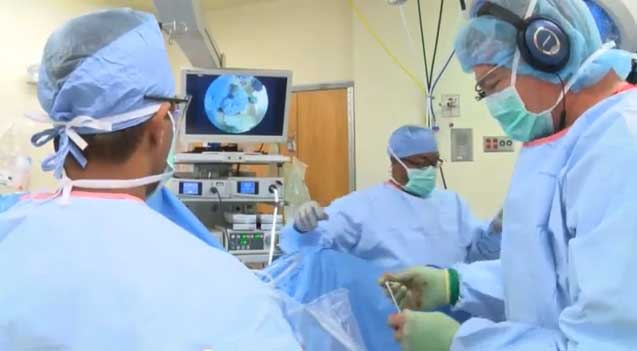A surgeon at The Ohio State University Wexner Medical Center is the first in the United States to consult with a distant colleague using live, point-of-view video from the operating room via Google Glass, a head-mounted computer and camera device.
“It’s a privilege to be a part of this project as we explore how this exciting new technology might be incorporated into the everyday care of our patients,” said Dr. Christopher Kaeding, the physician who performed the surgery and director of sports medicine at Ohio State. “To be honest, once we got into the surgery, I often forgot the device was there. It just seemed very intuitive and fit seamlessly.”
Google Glass has a frame similar to traditional glasses, but instead of lenses, there is a small glass block that sits above the right eye. On that glass is a computer screen that, with a simple voice command, allows users to pull up information as they would on any other computer. Attached to the front of the device is a camera that offers a point-of-view image and the ability to take both photos and videos while the device is worn.
During this procedure at the medical center’s University East facility, Kaeding wore the device as he performed ACL surgery on Paula Kobalka, 47, from Westerville, Ohio, who hurt her knee playing softball. As he performed her operation at a facility on the east side of Columbus, Google Glass showed his vantage point via the internet to audiences miles away.
Across town, one of Kaeding’s Ohio State colleagues, Dr. Robert Magnussen, watched the surgery his office, while on the main campus, several students at The Ohio State University College of Medicine watched on their laptops.
“To have the opportunity to be a medical student and share in this technology is really exciting,” said Ryan Blackwell, a second-year medical student who watched the surgery remotely. “This could have huge implications, not only from the medical education perspective, but because a doctor can use this technology remotely, it could spread patient care all over the world in places that we don’t have it already.”
“As an academic medical center, we’re very excited about the opportunities this device could provide for education,” said Dr. Clay Marsh, chief innovation officer at The Ohio State University Wexner Medical Center. “But beyond, that, it could be a game-changer for the doctor during the surgery itself.”
Experts have theorized that during surgery doctors could use voice commands to instantly call up x-ray or MRI images of their patient, pathology reports or reference materials. They could collaborate live and face-to-face with colleagues via the internet, anywhere in the world.
“It puts you right there, real time,” said Marsh, who is also the executive director of the Center for Personalized Health Care at Ohio State. “Not only might you be able to call up any kind of information you need or to get the help you need, but it’s the ability to do it immediately that’s so exciting,” he said. “Now, we just have to start using it. Like many technologies, it needs to be evaluated in different situations to find out where the greatest value is and how it can impact the lives of our patients in a positive way.”
Only 1,000 people in the United States have been chosen to test Google Glass as part of Google’s Explorer Program. Dr. Ismail Nabeel, an assistant professor of general internal medicine at Ohio State applied and was chosen. He then partnered with Kaeding to perform this groundbreaking surgery and to help test technology that could change the way we see medicine in the future.
If our reporting has informed or inspired you, please consider making a donation. Every contribution, no matter the size, empowers us to continue delivering accurate, engaging, and trustworthy science and medical news. Independent journalism requires time, effort, and resources—your support ensures we can keep uncovering the stories that matter most to you.
Join us in making knowledge accessible and impactful. Thank you for standing with us!

